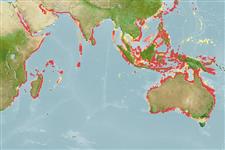Common names from other countries
Environment: milieu / climate zone / depth range / distribution range
Écologie
; profondeur 0 - 30 m (Ref. 7727). Tropical
Indo-Pacific and the Mediterranean Sea.
Length at first maturity / Taille / Poids / Âge
Maturity: Lm ? range ? - ? cm Max length : 4.0 cm TL mâle / non sexé; (Ref. 844)
Assumed maximum length from Ref. 844. Known from depths of 0 to 30 m (Ref. 7727). Feeds on hydroids, especially Halocordyle disticha (Ref. 108651).
Life cycle and mating behavior
Maturité | Reproduction | Frai | Œufs | Fécondité | Larves
Members of the order Nudibranchia are simultaneous hermaphrodites. Mating behavior: Both individuals darts their penis toward each other to induce one to act as a male and the other as the female. The victorious one to penetrate the body wall is the dominant male. Life cycle: Eggs are deposited on a substratum where they develop and hatch into (planktonic) vestigial veliger larval stage and further grow as adults.
Debelius, H. 2001. (Ref. 844)
Statut dans la liste rouge de l'IUCN (Ref. 130435)
statut CITES (Ref. 108899)
Not Evaluated
Not Evaluated
Menace pour l'homme
Harmless
Utilisations par l'homme
| FishSource |
Outils
Plus d'informations
Taille/Âge
Croissance
Longueur-poids
Longueur-longueur
Morphologie
Larves
Abondance
Sources Internet
Estimates based on models
Preferred temperature
(Ref.
115969): 17.7 - 29.2, mean 28 (based on 2154 cells).
Vulnérabilité
Low vulnerability (10 of 100).
Catégorie de prix
Unknown.
